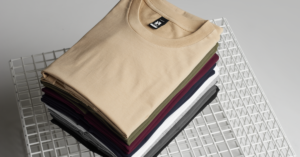How to Lower the Price of Printed and Embroidered T-shirts, Sweatshirts, Polo Shirts and Caps
Our clients frequently ask us, “How may we lower the price per unit of our order?” In this article, we explain the rationale about how the printed garment industry works, the differences in print types, print positions and their effect on pricing. Ultimately, the reader will understand how you may lower the price per unit with a garment order. Which will make it a lot easier when it comes to actually having to design the garments!
There are several ways how we may lower the cost per unit. The first thing we must consider is this that price differs with each, and every, printing technique. However, there is one consistent thing with all printing techniques. This is that price drops with quantity. This is especially the case with embroidery and screen printing techniques. This is because there are set up fees involved, so the more units one prints the more cost-effective it becomes, and this may radically reduce the individual unit price.
If a client chooses screen printing for their garment, the price is based on how many colours are used plus the print positions. It is important to remember that there are screen printing price breaks too. For direct to garment printing (DTG), the total amount of colours would not affect the price. This technique is reliant on print positions. With one colour vinyl and cut out the colour transfer, the price is again based on the print positions. The more you get printed of the same design, the greater the unit drops in price.
As a general rule of thumb, price breaks are at 25, 50, 100, 250, 1000, 2500 and 5000. So for example, to print 140 t shirts of the same design would prove more expensive in most cases than to print 150 units. This is because the unit price for 150 units would be cheaper than the 140 units. At Garment Printing, unlike other printers, we inform our clients of this information in order to assist them with their calculations.
Who Should Supply the Garments?
Many of our first time clients believe that if they provide their own garments then the service would work out cheaper. This is only the case if the client can get the garments cheaper per unit than ourselves. With our massive international supply chain and relationships with the manufacturers 99.9% of the time this is unlikely. We get the t shirts at trade price and pass the discount on to our customers.
Mark Speakman, head of the UK design and sales team commented on clients providing garments and its cost considerations, “On the whole, we dissuade clients away from a print-only service. As print professionals, we understand all the fabrics, machines, and processes and that is why we offer a 100% satisfaction guarantee. Once customers introduce a new, and at times a high-risk variable into the process, this affects the quality of the end product. As printed garment professionals we understand that dirty garments sent by the clients, together with the wrong sizes or amounts create a less time efficient process.”
Speakman explained the cost to the customer in terms of time risk, “A client will have to closely follow the order with us, answer questions from our production team in the office and on the floor, and be on-hand throughout the process. ”
“For both clients and ourselves, it works out more cost effective, with a 99% chance to have a very high-quality garment using our own clothing rather than introducing added high-risk, time, and cost inefficient complications into the equation with client-provided materials,” concluded Speakman.




